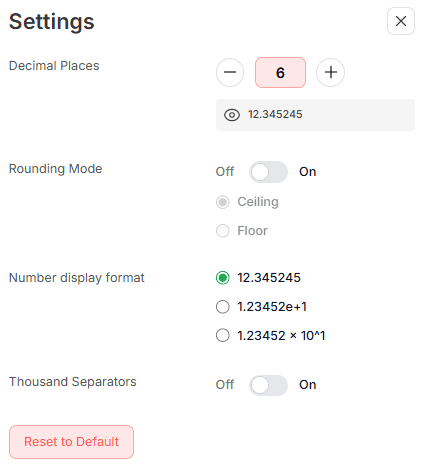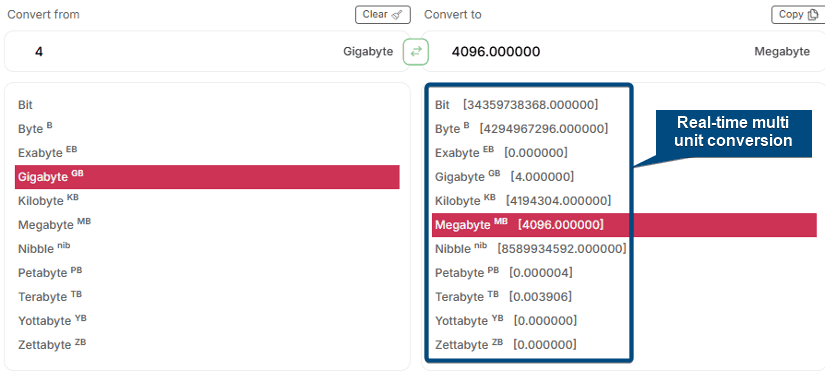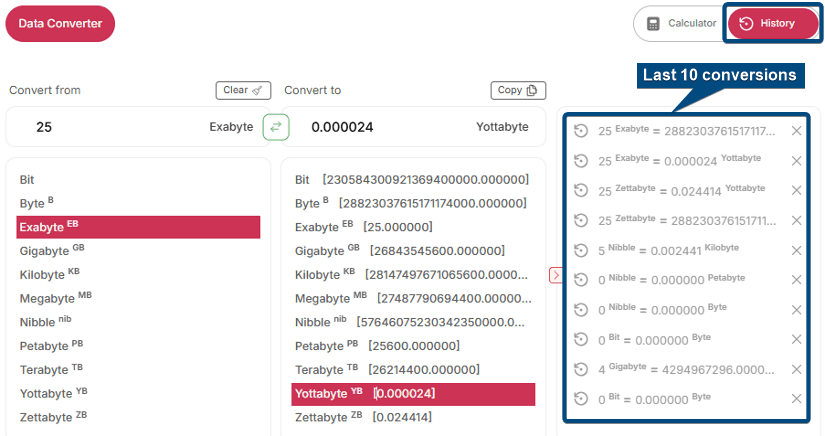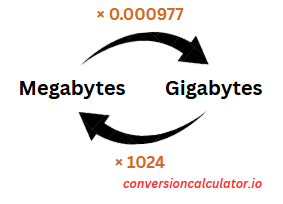HomeData Converter
Data Conversion Calculator
Switch between bits, bytes, and beyond—decode the full scale of digital storage.Data Converter
Convert from
Convert to
**Formula:
Discover Other Unit Converters
Updated on September 1, 2025
Our Data Storage Conversion Calculator is designed to make your digital storage conversions fast, simple, and reliable. Switch effortlessly between bits, bytes, kilobytes, megabytes, and more with just a few clicks. In this article, I’ll guide you through how our tool works, its powerful features, and how you can use it for accurate and efficient conversions.About Our Data Storage Conversion Calculator
Written By Nadiba Rahman
Nadiba Rahman
Reviewed by Mrinmoy Roy
Mrinmoy Roy
Share This Post
URL copied!
What is Data?
Data is information that a computer uses to store, process, or transfer. This information can be text, numbers, images, audio, or video. Every time you send a message, watch a video, or save a file, you are using data. Computers need data to run programs and show results.Data is measured in digital units to show how much information is being used or stored. The smallest unit is a bit, which stores a 0 or a 1. A byte equals 8 bits. Larger units include kilobytes (KB), megabytes (MB), gigabytes (GB), and terabytes (TB).
For example, a simple text file might be a few kilobytes, a photo may take up a few megabytes, while a full HD movie could be several gigabytes in size.
How is Data Storage Calculated?
Data storage is measured using two systems:- Binary system (base 2)
- Metric or Decimal system (base 10, International System of Units)
For data storage conversion, multiply or divide by these values depending on the unit. For example, to convert megabytes to kilobytes, multiply by 1024 (binary system) or 1000 (metric system). This helps you measure how much space a file or folder uses on a device.
Note: Our calculator uses the binary system for data storage unit conversions. This means your conversion formulas and results will follow this system.
Conversion Units of Our Data Storage Converter
Our data storage conversion calculator supports the following units:- Bit (b): The smallest data unit. It holds a value of 0 or 1. Bits measure data transfer rates, like internet speed (e.g., Mbps).
- Nibble (n): Equals 4 bits or half a byte. Common in hexadecimal numbers.
- Byte (B): Contains 8 bits. Used to measure file sizes, memory, and data transmission.
- Kilobyte (KB): Equals 1,024 bytes in the binary system. This differs from the metric system, where 1 KB equals 1,000 bytes.
- Megabyte (MB): Equals 1,024 kilobytes or 1,048,576 bytes. It measures small to medium files like images or documents.
- Gigabyte (GB): Equals 1,024 megabytes. It is about 1 billion bytes. Common for device storage, like phones and laptops.
- Terabyte (TB): Equals 1,024 gigabytes or roughly 1 trillion bytes. Used for large storage devices like external hard drives.
- Petabyte (PB): Equals 1,024 terabytes or 1 quadrillion bytes. Used in large-scale data centers and cloud storage.
- Exabyte (EB): Equals 1,024 petabytes or about 1 quintillion bytes. Used by internet service providers and global data systems.
- Zettabyte (ZB): Equals 1,024 exabytes or 1 sextillion bytes. Relevant for measuring global data growth.
- Yottabyte (YB): Equals 1,024 zettabytes or about 1 septillion bytes. Mostly used in scientific fields and for future data forecasts.
How to Use Our Data Storage Unit Converter?
Follow these simple steps to use our data storage conversion calculator:Select Source and Target Units
Choose the source and target units for conversion. As soon as you select them, a real-time formula preview appears (like the image below) to help you understand how the conversion works.
Enter the Input Unit Value
Enter the numerical value for the data storage you want to convert.
Get the Converted Results
The converted result appears instantly in the target unit.
Features of Our Data Storage Conversion Calculator
Our data storage conversion calculator includes several features that make conversions simple and efficient. All of them are easy to access from the settings menu, and the image below shows the default settings for each feature.
Adjustable Decimal Precision
In data storage, precision matters, especially when dealing with large volumes or technical requirements. A small decimal difference can lead to inaccurate capacity planning, overuse of resources, or misinterpretation of file sizes.Our data storage conversion calculator lets you set the exact number of decimal places you need from 0 to 12. By default, results are displayed up to 6 decimal places, but you can adjust this based on how precise your work requires.
For example, if you choose 10 decimal places, the result might show as 3.7252902985 MB instead of rounding it to 3.73 MB. This level of control helps when working with precise memory allocations, network bandwidth calculations, or technical documentation that demands accuracy.
Rounding Mode
In data storage, even small rounding differences can cause problems, especially when managing disk partitions, allocating quotas, or setting backup sizes. A slight miscalculation can lead to exceeding limits or wasting space.That’s why our calculator includes flexible rounding mode options. You can round up, down, or turn rounding off completely. This gives you control over how values are handled and helps ensure your conversions match the exact requirements of your system or project.
Flexible Number Format
Data storage can involve both tiny values like bits and huge ones like terabytes. Without a clear format, numbers can be hard to read or interpret. Our calculator supports three different number display formats, so you can choose what works best:- Standard Decimal (e.g. 12.34524502)
- Scientific Notation (e.g. 1.2345245e+1)
- Engineering Format (e.g. 1.2345245 × 10^1)
Switching to scientific (3.75962312e-9 GB) or engineering (3.75962312 × 10⁻⁹ GB) formats makes these numbers easier to read, compare, and report, especially in technical work like data transmission or memory planning.
Real-Time Multi-Unit Conversion
Data is stored and measured in different units like bytes, kilobytes, megabytes, and gigabytes. Converting between them manually takes time and increases the chance of mistakes.Our data storage converter solves this with real-time multi-unit conversion. When you enter a value, it instantly shows the equivalent results in all other data storage units. This is especially useful when you need to compare values, like how many megabytes are in a gigabyte, or how many bits are in a kilobyte, without doing separate conversions.
For example, if you convert 4 gigabytes to megabytes, the calculator will instantly display the equivalent values in all other units in real time, as shown in the image below:

Thousand Separators Toggle
When working with large data values like bytes or bits, numbers can be hard to read quickly. One missing digit can lead to errors in storage planning or file transfers.The thousand separator toggle adds commas to break up long numbers. For example, 29375104 bytes becomes 29,375,104 bytes, making it easier to scan, compare, and copy results accurately.
Integrated Scientific Calculator
When working with data storage, you often need quick calculations, like dividing total storage by the number of users or doubling a file size before converting. Switching to another tool slows you down and can lead to copy-paste errors.That’s why our data storage converter includes a built-in calculator. You can do basic math, like adding, subtracting, multiplying, or dividing, without leaving the tool. Once you’re done, you can instantly send the result to the converter.
For example, if you’re allocating 200 GB across 8 users, divide it right inside the calculator and instantly convert the result (25 GB) into megabytes or kilobytes with one click.
Quick Unit Swap
When you need to check values in both directions, like converting GB to MB and then MB to GB, the unit swap button makes it easy. It instantly flips the input and output units, saving you from retyping and helping you compare results faster.Clickable and Auto-Saved Conversion History
When working on multiple data storage conversions, it’s easy to lose track of your last values. Our converter automatically saves your last 10 conversions, even if you refresh or close your browser.Just open the History tab and click on any past entry to reload it instantly; no need to retype anything. This saves time and reduces mistakes when you’re switching between different storage size conversions.

Data Storage Conversion Table
Here's a simple data storage conversion table that shows how different data units relate in the binary system:| Unit | Value in Bytes (B) |
|---|---|
| 1 bit (b) | 1/8 byte |
| 1 nibble (n) | 1/2 byte |
| 1 byte (B) | 1 byte |
| 1 kilobyte (KB) | 1,024 bytes |
| 1 megabyte (MB) | 1,024 kilobytes (KB) |
| 1 gigabyte (GB) | 1,024 megabytes (MB) |
| 1 terabyte (TB) | 1,024 gigabytes (GB) |
| 1 petabyte (PB) | 1,024 terabytes (TB) |
| 1 exabyte (EB) | 1,024 petabytes (PB) |
| 1 zettabyte (ZB) | 1,024 exabytes (EB) |
| 1 yottabyte (YB) | 1,024 zettabytes (ZB) |
Download the following Data Storage Conversion Chart to find all the conversion factors and compare different data storage units in one place.
2 Examples of Conversion With Our Data Storage Converter
Our data storage converter helps you switch between units like bytes, kilobytes, megabytes, gigabytes, and terabytes. Each conversion uses a factor that shows how one unit converts to another, and you can see these factors in the Data Storage Conversion chart above. Here’s how it works:Converted Value = Conversion Factor × Source ValueHere are two quick examples:
1. Convert Megabytes to Gigabytes
From the chart, 1 MB ≈ 0.000977 GB. So, to convert 1300 MB to GB:
1300 × 0.000977 ≈ 1.3 GB To go back from GB to MB, multiply by 1024.
To go back from GB to MB, multiply by 1024.
1300 × 0.000977 ≈ 1.3 GB

2. Convert Bytes to Kilobytes
From the chart, 1 byte ≈ 0.000977 KB. So, to convert 2048 bytes to KB:
2048 × 0.000977 = 2.000896 KB For reverse conversion, use the factor 1024.
For reverse conversion, use the factor 1024.
2048 × 0.000977 = 2.000896 KB


